Hasegawa 1/32 Scale P-51D Mustang
By Jay Wheaton
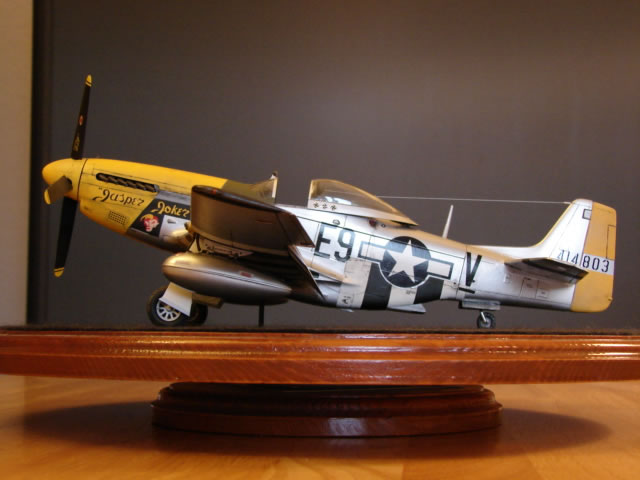
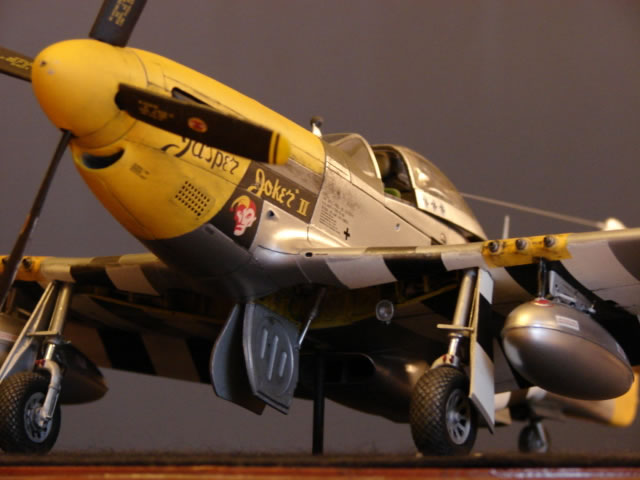
I have been modeling about 4 years now, and I have built up a few P-51s at 1/48, 1/32, and even 1/24. This is my latest, and probably last (my eyes are going). Isn’t it a shame how little is offered in 1/32 for the premier WWII fighter? Anyway, the 1/32 Hasegawa kit is just about all we have, but with a lot of work (a little won’t really do) it can become a real eye-popper.
This model represents the 361st FG, 376th FS aircraft “Jasper Joker”, flown by a Lieutenant Donald Vulgamore from Jasper, Ohio. I have wanted to do a yellow nose Mustang ever since I saw the movie “Hart’s War” where 361st Mustangs work over a German marshalling yard in spectacular fashion. It was good to see the Aeromaster decal set come out.
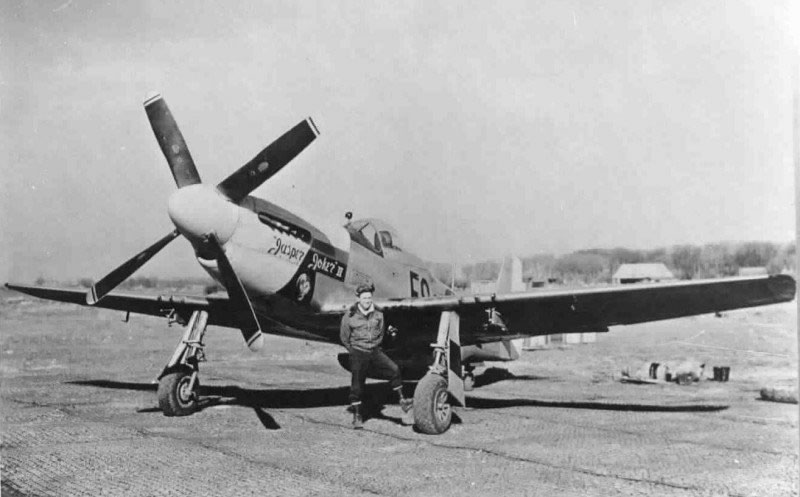
For the really anal purists out there, I will admit right off that there are a few things different about the model as opposed to the real thing – D-day stripes, yellow accent on the gun panels, and perforated air filter panels (all research I have done suggests the 361st used non-perforated “winter” panels) are my own additions. Oh, and I’m not sure if the yellow paint was really masked off for the serial number on the rudder – one picture of the aircraft showed it that way and it looks cool. Call it my artistic license.
Wheel Well and Main Landing Gear
The Hasegawa kit has an atrocious wheel well, and atrocious main landing gear – abject lack of detail, and the universal P-51 model error of a rear spar that follows the shape of the wheel well cutouts, instead of straight. So I ground away the offending wheel wells (wow – what scary work) and essentially stole the wheel well components from a Rutman P-51B all-resin kit, and with some significant scratch building (the stringers and inside panels) came up with a better representation. I cannot tell you how much time I spent on these wheel wells.
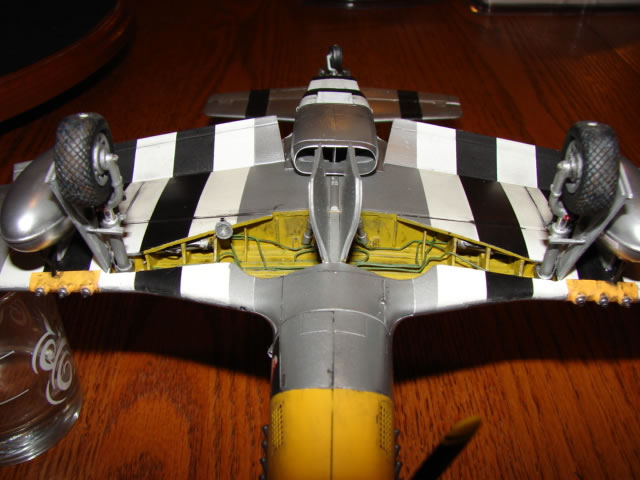
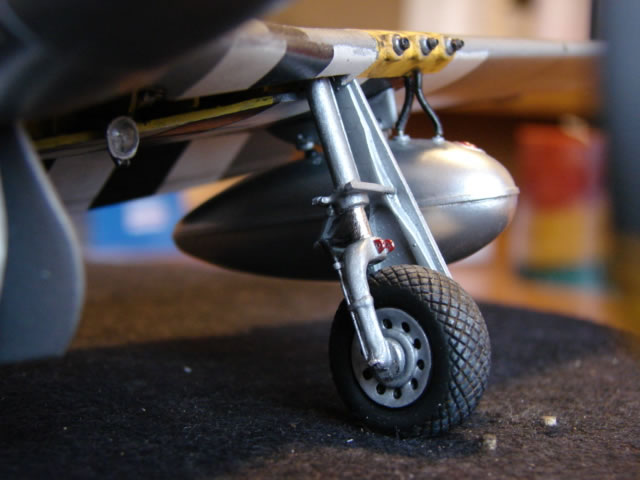
The main landing gear are also Rutman (white metal), but I cut them in half, drilled holes, and inserted brass rod for the oleo’s (covered with alum foil). Also I bonded rotating shafts onto the upper ends of the gear and scratch built representative support structure – this really added robustness to the gear but made gear installation most difficult. Note the landing gear actuators – can you see them? And note the attempt to add hydraulic lines – I got most (but not all) of them. Gear door links were scratch built out of styrene rod, and brake lines were made from copper wire and vinyl wire sheathing. Note – the Hasegawa gear doors are too long by about .05 inch or so. Mine are trimmed to the right size. Tires/wheels are True Detail of course!
The Wing
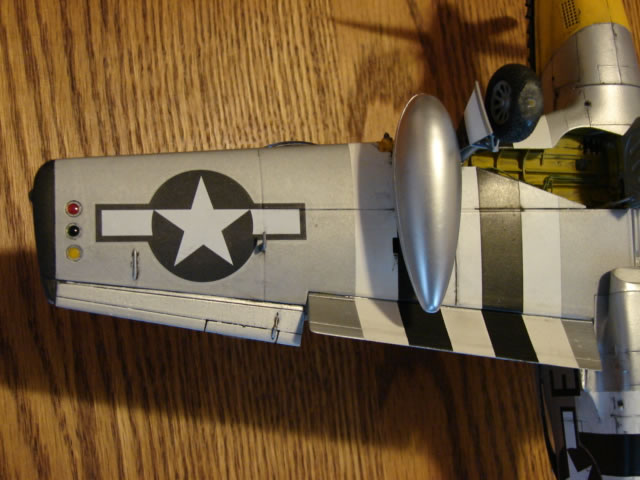
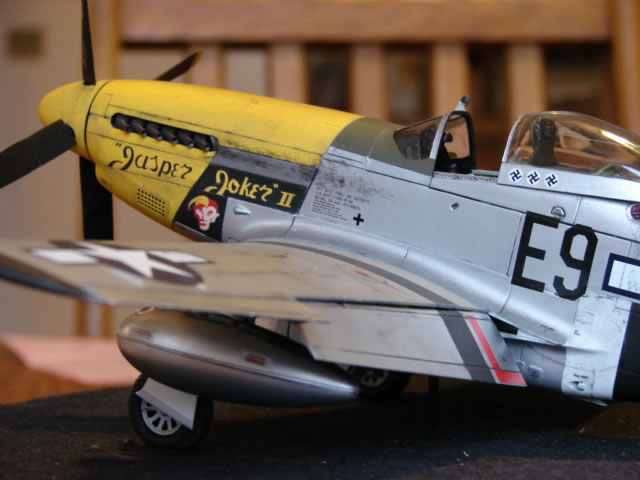

I sanded down the infamous Hasegawa rivet heads, and cut off the flaps and ailerons so I could use the resin Rutman parts from his B model, and drop the flaps to full down, as all Mustangs were after a few minutes on the ground with no hydraulic pressure. This was no easy thing – the Rutman parts needed lots of work, and the remaining wing needed a scratch built rear spar extension to maintain its correct thickness. The sway braces for the external tanks are scratch built – the Hasegawa ones are a joke. Note the plumbing on the tank – some of you will notice that it’s an anachronism; it wasn’t until later that Mustangs had this simpler arrangement. I found out too late and I’m too lazy to change it! The neat ID lights come from an Eduard PE kit, with drops of 2-part epoxy for the lenses. The wing is painted with Testors silver with dull coat – Mustang wings were not NMF, but some sort of paint from the factory.
The Machine Guns
Here Hasegawa fails us again. The barrels are supposed to be supported on roundish housings and not exposed. So I completely scratch built them using metal tube and plastic rod.

The Cockpit
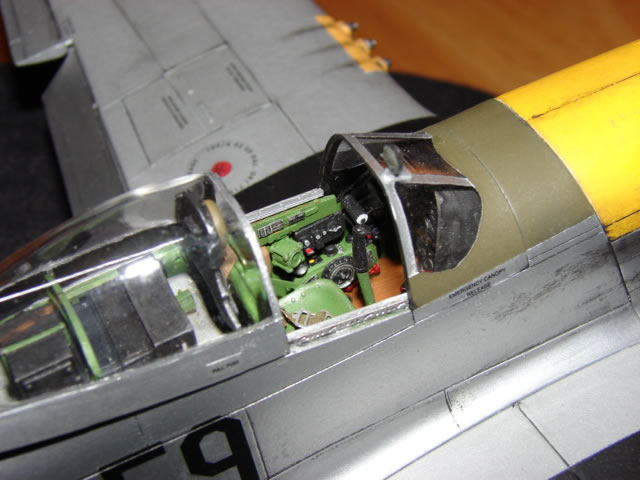
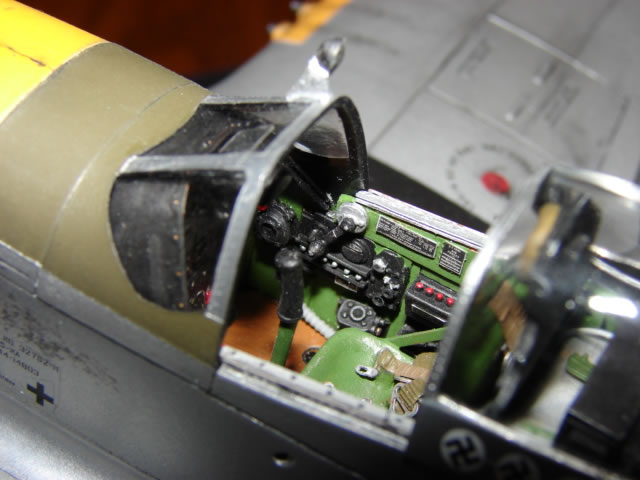
The cockpit is the venerable Verlinden kit. This is a very detailed kit but it has A LOT of problems – unforgivable in my opinion because the kit costs a lot of money. The worst is that it doesn’t fit in the space provided!! Not even close. This is mostly because the parts are too large, from the seat to the seatbelts to the throttle quadrant and other stuff. Yes – they are out of scale – what’s up with that? So I decided to do a digital model of it, and not use the sidewalls provided in the kit (this provided me more space). I solved the interference problems on the computer mock up instead of on the actual model, and as long as I fabbed the parts close to the way they were solid-modeled, they fit really nice. I pilfered the auxiliary fuselage tank out of the Rutman kit and put it in to replace the ridiculous non-part in the Hasegawa kit. The pilot armor plate is scratch built completely. It is probable the late war radios (included in the Verlinden kit) are anachronistic as well – gosh, I am giving away my secrets…
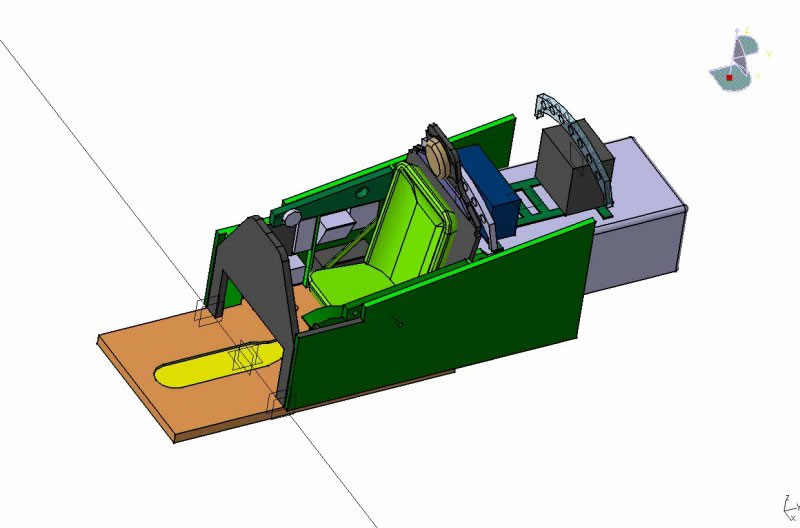
For those few of you who have a CAD software suite of some kind, I highly recommend solid modeling parts, and creating geometry to help scratch build kits.
Fuselage, Tail, Etc
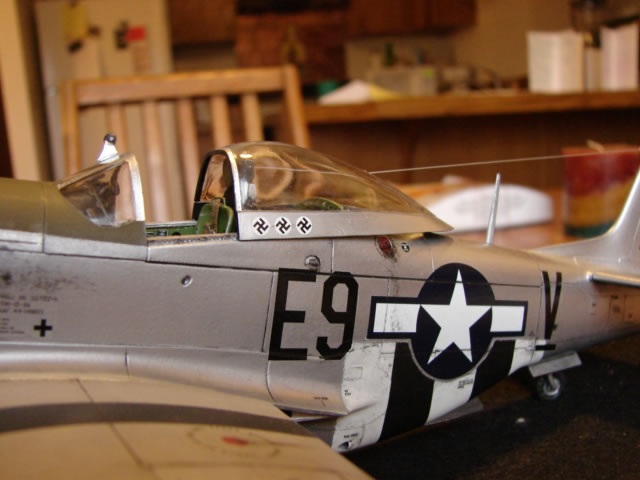
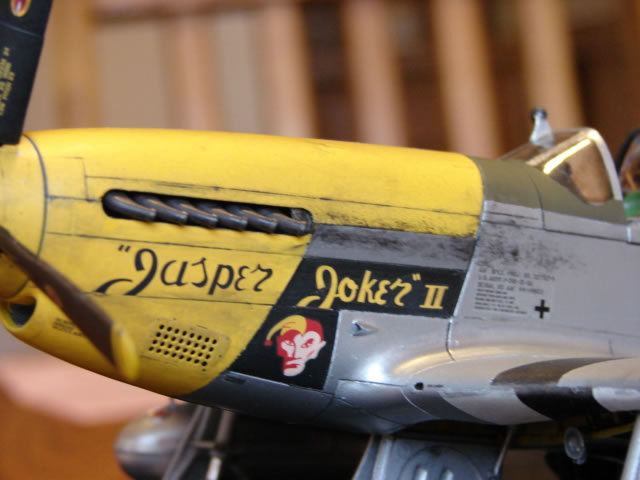
First the nose – I augmented the roots of the prop blades because Hasegawa has these little spindly prop roots. That took styrene, glue, and lots of filing. I then bored out larger holes in the bullet fairing, more like the real deal, created an alignment tool, and installed the props with representative pitch.
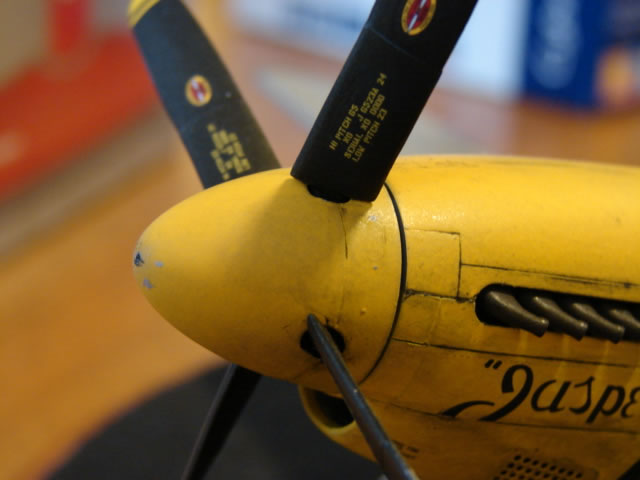
The engine was (highly) modified to accept the excellent Moskit exhaust stacks. Part of the reason I selected this particular Mustang example is because it has uncovered exhaust stacks and I love the Moskit parts. Anyway the engine had to be sawed up pretty good – it is good that it doesn’t show.
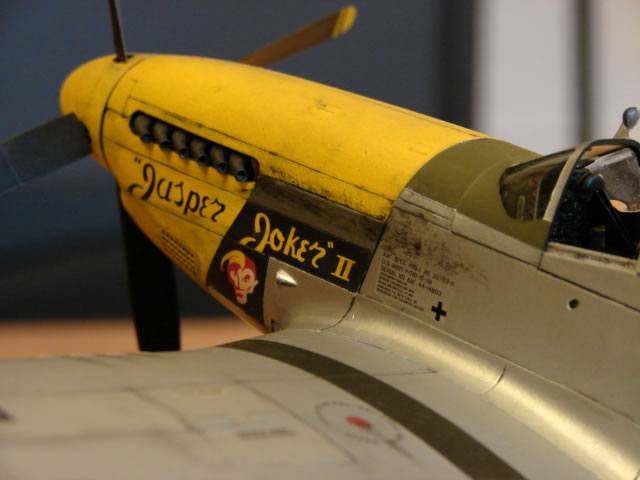
The air filter panels, although not authentic for this particular airplane, come from the Rutman kit. Much better than what the Hasegawa kit offers, even when drilled.
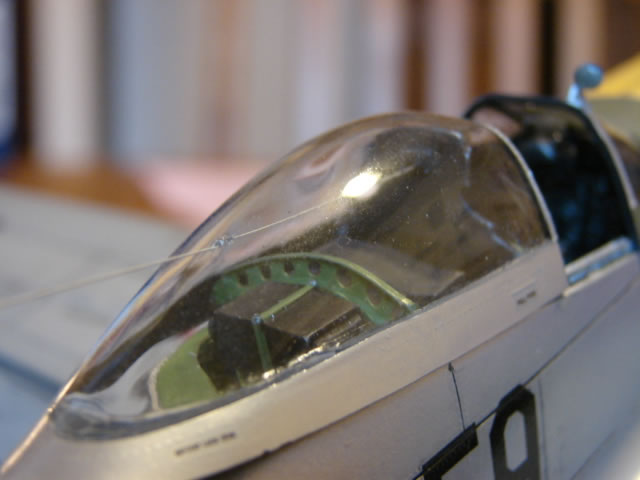
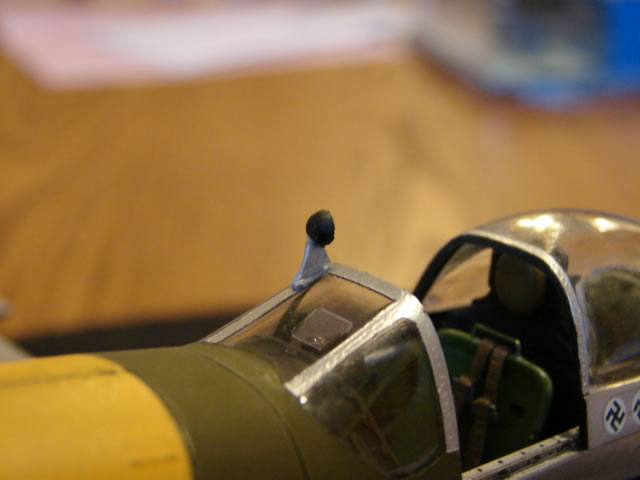
I don’t like the Hasegawa canopy – it is out of scale in several ways. It is not tall enough, and the aft portion of the sliding canopy just isn’t right. Tamiya did much better (in 1/48) though). And guess what! The True Details vac part is the same way as the Hasegawa, so no help. How frustrating. I wonder where they got their vac molds... Anyway, I used the Hasegawa parts without modification. The canopy brace however is scratch built. Please note the asymmetric location of the non-standard mirror, per the war photo. I wonder why he did that. I have half a mind to make one for the other side.
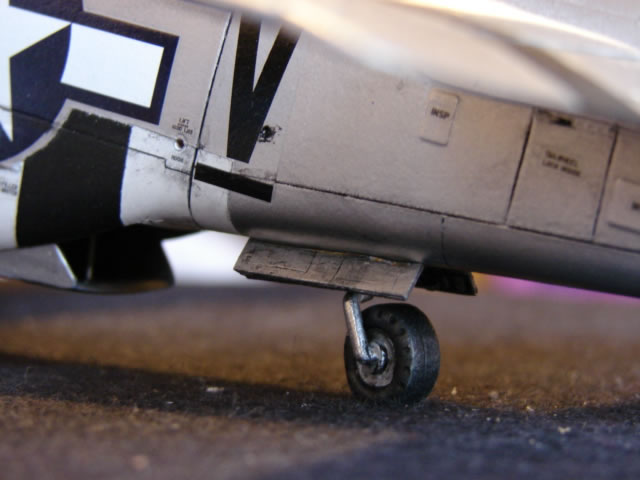
Moving aft, the Hasegawa tail wheel was replaced. It is part Rutman (white metal strut and resin wheel/tire), part Hasegawa, and part scratch built. I actually widened the tire to accurate scale by sawing it in half and adding sheet styrene. And I scratch built the hub because the Rutman hub is from a P–51A!! Go figure. Note that the tire is slightly flattened – very cool; thanks Jerry. A future fun project is to add tail wheel door links – microsurgery for sure. By the way, I accidentally glued the fuselage halves together without inserting the tail gear first. I do not recommend this at all.
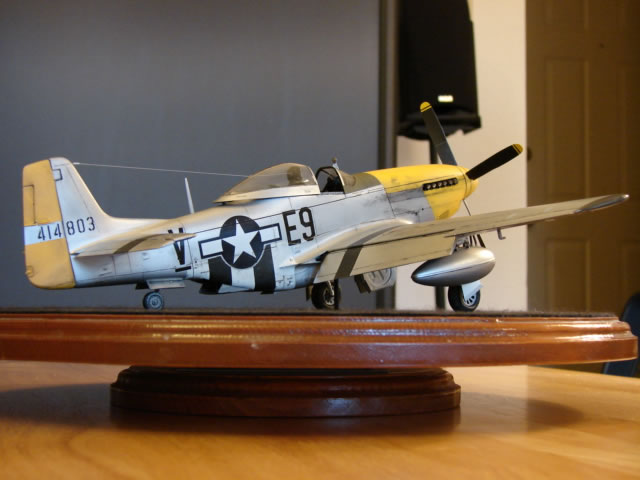
The fixed elevators and rudder were sawed away and replaced by the Rutman separate units. Lots of sanding and panel line restoration work here on the control surfaces.
The fuselage itself was sanded down to eliminate the proud-standing rivet heads, did some panel line scribing, and painted using Testors Aluminum metalizer lacquer. It is really tough to have to wait until last to get the NMF on, but I know no other way which is compatible with masking.
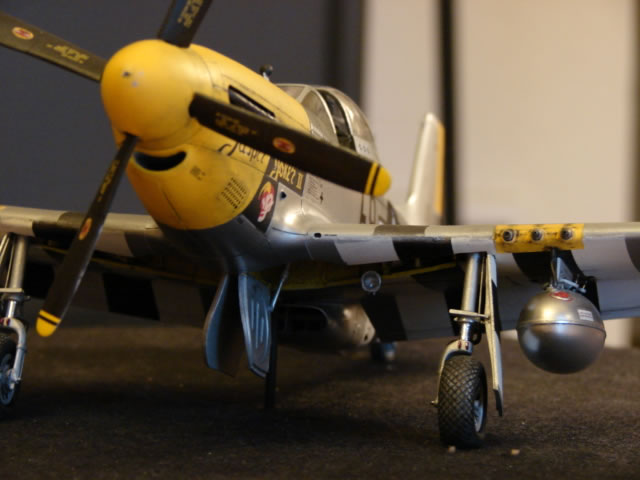
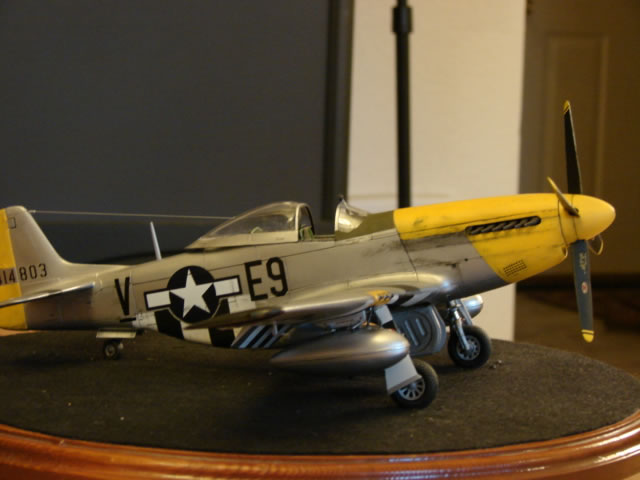
You might notice the strut underneath. This unfortunately is an absolute requirement. The model is a bit heavy, and to my chagrin I have found that white metal landing gear sag with time – a horrifying eventuality for spending so much time and effort on landing gear.
This model took approximately 300 to 350 hours to complete. And I spent perhaps $200 for it and the aftermarket kits (the Rutman kit alone was $90 plus shipping). It is high time that someone out there produces an awesome 1/32 scale P-51 (Tamiya?). Although extremely gratifying, this was just too much work. I’d like to see someone do for the 1/32 P-51D what Trumpeter did with the 1/32 Corsair or P-38, and apply it to the Mustang (and pay no attention at all to their 1/24 scale oddity).
I hope you enjoy this replication.
Materials
- Hasegawa 1/32 P-51D
- Jerry Rutman resin P-51B full-up kit
- True Details wheels
- Verlinden P-51D cockpit update set
- Waldron instruments and placards
- Eduard Mustang Detail Set
- Aeromaster “Yellow Nose Mustangs of the 361st FG, Pt 1”
© Jay Wheaton 2006
This article was published on Wednesday, July 20 2011; Last modified on Tuesday, April 12 2022
